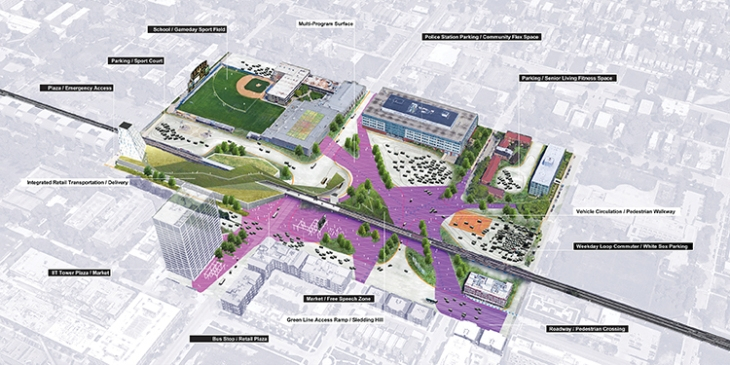In March of 2016, the landscape architect Ron Henderson, FASLA, had the rare opportunity to visit Mcity, the autonomous vehicle research center at the University of Michigan in Ann Arbor. His entourage, which included Nilay Mistry, ASLA, as well as an architect, a transportation engineer, a social scientist, and an attorney, signed in at a gatehouse worthy of a military facility. They were then relieved of all cameras and recording devices—“It’s like a top-secret corporate espionage kind of place,” Henderson says—before being escorted on a brief tour of a 16-acre test track composed of every road condition imaginable: bridges, tunnels, gravel roads, bike lanes, railroad crossings, roundabouts, graffiti-defaced road signs, faded lane markings, a main street with parallel parking, and a short stretch of freeway. “They even have a little Potemkin village of fake storefronts,” Henderson says.
....
Designers have produced reams of renderings depicting this future driverless utopia: rain gardens instead of parking lanes, swimming pools in unexpected places, urban farms blanketing former parking lots, and parking garages repurposed as yoga studios, maker spaces, and microcondos for the twentysomethings of the future. People won’t own cars so much as subscribe to a ride-sharing service, the thinking goes, eliminating the need for residential parking. Driverless cars will drop you off wherever you need to go, and then speed off to pick up the next passenger—so say sayonara to commercial parking as well. At night, driverless cars will sleep in vacant lots outside the city, cuddled close together like bees in a hive. They’ll drive in a swarm-like fashion, too, aligning themselves in groups on the highway according to their destination. With the risk of collisions eliminated, lane widths will shrink, and groups of cars will drive nearly bumper to bumper, train-like, saving even more asphalt-covered ground for better uses.
It’s the stuff of landscape architects’ dreams. The Driverless City project book is full of such imagery, but Henderson cautions that the new technology isn’t going to magically create these desired outcomes, unless planners, designers, and policy makers steer it that way. The companies invested in AV technology certainly don’t mind the PR buzz of all those renderings and infographics, but they are in the business of selling technology, not fixing everything that ails our cities.
One poorly thought-through scenario Henderson points to is the repurposing of parking lanes as gardens or expanded pedestrian zones. He agrees with the notion that curbside parking will eventually become obsolete, but he thinks the space will be needed to accommodate an increase in deliveries instead, of both goods and people. “We are already seeing more curbside obstructions from Uber and delivery trucks, which are going to continue to rise as everything starts to be delivered by an on-demand driverless car. So, streets may actually get more congested.”
....
